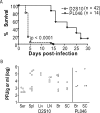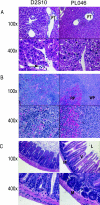Murine model for dengue virus-induced lethal disease with increased vascular permeability
- PMID: 17005698
- PMCID: PMC1617308
- DOI: 10.1128/JVI.00062-06
Murine model for dengue virus-induced lethal disease with increased vascular permeability
Abstract
Lack of an appropriate animal model for dengue virus (DEN), which causes dengue fever and dengue hemorrhagic fever/dengue shock syndrome (DHF/DSS), has impeded characterization of the mechanisms underlying the disease pathogenesis. The cardinal feature of DHF/DSS, the severe form of DEN infection, is increased vascular permeability. To develop a murine model that is more relevant to DHF/DSS, a novel DEN strain, D2S10, was generated by alternately passaging a non-mouse-adapted DEN strain between mosquito cells and mice, thereby mimicking the natural transmission cycle of the virus between mosquitoes and humans. After infection with D2S10, mice lacking interferon receptors died early without manifesting signs of paralysis, carried infectious virus in both non-neuronal and neuronal tissues, and exhibited signs of increased vascular permeability. In contrast, mice infected with the parental DEN strain developed paralysis at late times after infection, contained detectable levels of virus only in the central nervous system, and displayed normal vascular permeability. In the mice infected with D2S10, but not the parental DEN strain, significant levels of serum tumor necrosis factor alpha (TNF-alpha) were produced, and the neutralization of TNF-alpha activity prevented early death of D2S10-infected mice. Sequence analysis comparing D2S10 to its parental strain implicated a conserved region of amino acid residues in the envelope protein as a possible source for the D2S10 phenotype. These results demonstrate that D2S10 causes a more relevant disease in mice and that TNF-alpha may be one of several key mediators of severe DEN-induced disease in mice. This report represents a significant advance in animal models for severe DEN disease, and it begins to provide mechanistic insights into DEN-induced disease in vivo.
Figures






Similar articles
-
Alternate hypothesis on the pathogenesis of dengue hemorrhagic fever (DHF)/dengue shock syndrome (DSS) in dengue virus infection.Exp Biol Med (Maywood). 2008 Apr;233(4):401-8. doi: 10.3181/0707-MR-198. Exp Biol Med (Maywood). 2008. PMID: 18367628 Review.
-
Comparison of dengue-1 virus envelope glycoprotein gene sequences from French Polynesia.Am J Trop Med Hyg. 2004 Oct;71(4):478-84. Am J Trop Med Hyg. 2004. PMID: 15516646
-
Dengue virus infection and immune response in humanized RAG2(-/-)gamma(c)(-/-) (RAG-hu) mice.Virology. 2007 Dec 5;369(1):143-52. doi: 10.1016/j.virol.2007.06.005. Epub 2007 Aug 16. Virology. 2007. PMID: 17707071
-
Tumor necrosis factor-alpha, transforming growth factor-β1, and interleukin-10 gene polymorphisms: implication in protection or susceptibility to dengue hemorrhagic fever.Hum Immunol. 2010 Nov;71(11):1135-40. doi: 10.1016/j.humimm.2010.08.004. Epub 2010 Aug 21. Hum Immunol. 2010. PMID: 20732366
-
Dengue hemorrhagic fever with special emphasis on immunopathogenesis.Comp Immunol Microbiol Infect Dis. 2007 Sep;30(5-6):329-40. doi: 10.1016/j.cimid.2007.05.010. Epub 2007 Jul 23. Comp Immunol Microbiol Infect Dis. 2007. PMID: 17645944 Review.
Cited by
-
Animal models of dengue virus infection.Viruses. 2012 Jan;4(1):62-82. doi: 10.3390/v4010062. Epub 2012 Jan 9. Viruses. 2012. PMID: 22355452 Free PMC article. Review.
-
Tracking the evolution of dengue virus strains D2S10 and D2S20 by 454 pyrosequencing.PLoS One. 2013;8(1):e54220. doi: 10.1371/journal.pone.0054220. Epub 2013 Jan 14. PLoS One. 2013. PMID: 23342105 Free PMC article.
-
Sculpting humoral immunity through dengue vaccination to enhance protective immunity.Front Immunol. 2012 Nov 8;3:334. doi: 10.3389/fimmu.2012.00334. eCollection 2012. Front Immunol. 2012. PMID: 23162552 Free PMC article.
-
Slow resolution of inflammation in severe adult dengue patients.BMC Infect Dis. 2016 Jun 14;16:291. doi: 10.1186/s12879-016-1596-x. BMC Infect Dis. 2016. PMID: 27301555 Free PMC article.
-
Meta-analysis of all immune epitope data in the Flavivirus genus: inventory of current immune epitope data status in the context of virus immunity and immunopathology.Viral Immunol. 2010 Jun;23(3):259-84. doi: 10.1089/vim.2010.0006. Viral Immunol. 2010. PMID: 20565291 Free PMC article.
References
-
- Alvarez, D. E., A. L. De Lella Ezcurra, S. Fucito, and A. V. Gamarnik. 2005. Role of RNA structures present at the 3′UTR of dengue virus on translation, RNA synthesis, and viral replication. Virology 339:200-212. - PubMed
-
- An, J., J. Kimura-Kuroda, Y. Hirabayashi, and K. Yasui. 1999. Development of a novel mouse model for dengue virus infection. Virology 263:70-77. - PubMed
-
- Atrasheuskaya, A., P. Petzelbauer, T. M. Fredeking, and G. Ignatyev. 2003. Anti-TNF antibody treatment reduces mortality in experimental dengue virus infection. FEMS Immunol. Med. Microbiol. 35:33-42. - PubMed
Publication types
MeSH terms
Substances
LinkOut - more resources
Full Text Sources
Other Literature Sources
Molecular Biology Databases

